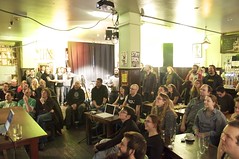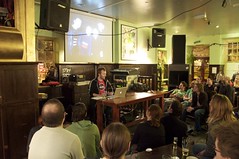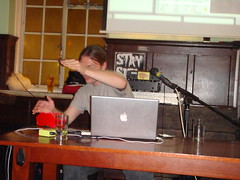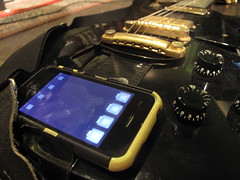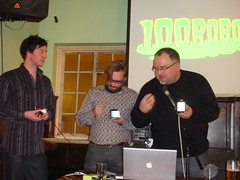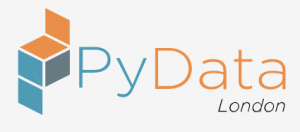Entrepreneurial Geekiness
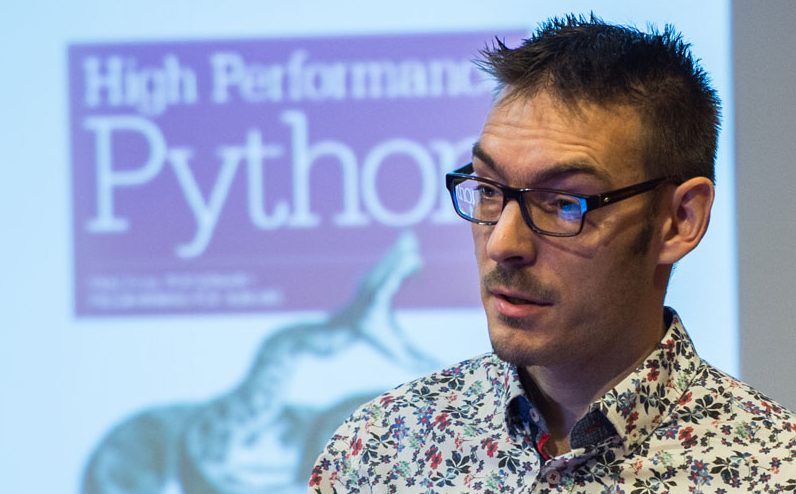
Sharing the Mac OS X clipboard with X11 apps
I’m using WingIDE on my MacBook and I couldn’t get copy/paste to work between WingIDE (running in X11) and native apps. This meant copying URLs and code snippets was impossible…hugely frustrating!
There is a simple fix, as outlined here just run the Property List Editor, open the specifed .plist, tick the 5 checkboxes, save, restart all of X11 and then the clipboard is shared between X11 and native apps. Phew.
Ian is a Chief Interim Data Scientist via his Mor Consulting. Sign-up for Data Science tutorials in London and to hear about his data science thoughts and jobs. He lives in London, is walked by his high energy Springer Spaniel and is a consumer of fine coffees.
£5 App Music-Themed Xmas Special
On Wednesday night we ran our music-themed £5 App Xmas Special (fivepoundapp.com).
It was fab! John and I had a fab time organising things and watching the night run so down-to-earthly – it seems that many others did too. I particularly like:
“I bloomin’ love £5 app! The event that’s happy to be itself, and is more rewarding for all as a result. Here with @ribot & @lastminute teams” – ribotminimus
“Home from #fivepoundapp, letting the awesomeness sink in.” – j4mie
Get to the end of the very last video and you’ll hear a special £5 App rendition of Jingle Bells.
Note: I want photos! Email me links to flickr’d images please. I also want your blog write-ups, mail them to me or comment down below.
Particular thanks for our sponsors Alan Newman (Sensible Development) and Paul Silver (PaulSilver.co.uk) along with John (psychicorigami) and my ProCasts for putting up cash to fund a few hours of free beer. Also super-huge thanks to the Ribots for supplying piles of mince pies (yummy!) and John for baking a batch of crunchy cookies.
The event was organised through Philip and Declan of PlayGroup, they use Hector’s House for arts and science gigs (thanks BuildBrighton for the connection!). Cheers chaps, it was exactly the space we needed!
“Seb’s Slightly Failed Music Career”
Seb spoke on the highs and lows of forming a band, showed previously-unseen footage and generally gave the lowdown on how it all works. Rick-rolling was included. Seb has his own write-up.
Sadly Seb’s hard-drive died after the talk taking all his transcoded footage but on the flip-side Seb inspired Simon to share footage from his old cover band.
Here’s the 60 minute video of Seb’s talk:
£5 App #20 “Seb’s Slightly Failed Music Career” for the 2009 Xmas Special from IanProCastsCoUk on Vimeo.
We were absolutely honoured that Seb and Jenny unveiled their new Xmas song tonight, see it here and share it around:
“Toby Cole – Zero to Theremin in 20 days” (with demo)
Toby Cole shows the ThereThing constructed through BuildBrighton and unveiled at a live gig the previous month.
Paul Silver took a video of the ThereThing in action:
Sadly the ThereThing is slightly out of shot during the video of the talk but you can hear Toby and see the screen just fine (and the ThereThing link shows it in detail).
£5 App #20 “Toby Cole – Zero to Theremin in 20 days” for the 2009 Xmas Special from Ian Ozsvald on Vimeo.
“Jim – Mrmr/LiveAPI guitar-mounted iPhone ableton live interface”
Jim Purbrick showed Mrmr, the LiveAPI guitar mounted iPhone Ableton live interface. Jim’s also the head of Second Life (UK) and is known for building robots.
£5 App #20 “Jim Purbrick – Mrmr/LiveAPI guitar mounted ableton live interface” for the 2009 Xmas Special from Ian Ozsvald on Vimeo.
“Lastminute.com Lab’s with Bottle-Rock-It” (with an additional proper demo video)
Richard, Sam and Mathias (LastMinute.com Labs) came down from London (thanks guys!) to demo Bottle-Rock-It, a group iPhone musical instrument.
The background talk gives loads of detail, sadly the demo went a bit sideways so we sang Jingle Bells as a loud (and slightly tipsy) group instead.
Check this BBC News story to see Bottle Rock It in action.
£5 App #20 “Lastminute.com’s Bottle-Rock-It” for the 2009 Xmas Special from Ian Ozsvald on Vimeo.
100 Robots (band)
After the talks finished Jim Purbrick and Max went on to play live n’loud as 100 Robots.
2010 and beyond…
If you want to keep in touch with future £5 App events then join the £5 App Google Group – it is very low volume and is mostly there just for the announces.
We’ll probably run some more competitions next year, the 5k competition went very well and John wants to do more around that idea and I want to play with some open-source A.I. kits. Details to follow.
Ian is a Chief Interim Data Scientist via his Mor Consulting. Sign-up for Data Science tutorials in London and to hear about his data science thoughts and jobs. He lives in London, is walked by his high energy Springer Spaniel and is a consumer of fine coffees.
A quick look at four chatbots
This is a quick review of four chatbot that are easily found on the web. I’ll take a look at the granddaddy ELIZA (wikip), A.L.I.C.E. (wikip) which uses AIML, Fake Kirk (with speech synthesis and a face) and O2’s Ask Lucy.
The goal of these chats was to see how each of the bots broke down and to learn about how the different technologies worked. ELIZA has a small, hard-coded rule set. A.L.I.C.E. is rule driven but with a big AIML rule set. Fake Kirk uses statistical training on Star Trek scripts. I don’t know what O2 use (but it doesn’t feel very sophisticated at all!).
ELIZA
A.L.I.C.E.
Fake Kirk
I’m also adding this 10 min video on Fake Kirk by someone from Pandorabots, it might be the author of Fake Kirk:
O2’s Ask Lucy
Ian is a Chief Interim Data Scientist via his Mor Consulting. Sign-up for Data Science tutorials in London and to hear about his data science thoughts and jobs. He lives in London, is walked by his high energy Springer Spaniel and is a consumer of fine coffees.
Printable local data sheet for visitors?
Here’s a simple idea to help visitors to a new area. Maybe it’s been done before and someone can leave a comment about it?
The problem – when you visit a place you don’t know you have no idea what you need to see, where to get a map, which pubs and cafes are nice, where the worthy landmarks are etc.
Possible solution – visit a site that gives you 1-2 pages of printable (or iPhoneable) data culled from WikiPedia, OpenStreetMap/GMaps, OpenPlaques, Flickr, Twitter and more. The pages would give you a summary of what’s there to see, some history, maps and also some recent information (probably via Twitter).
The printable option would be useful, iPhone coverage still isn’t great in the UK in the smaller and more interesting towns.
Personally I’d use this – we go walking to places that we don’t know every weekend and some background, a map and some topical info (e.g. are there any fairs or events happening today?) would be super useful. I’d guess that this would be useful for anyone visiting an area, even just for parents coming to visit for the weekend.
Does anything like this already exist?
Ian is a Chief Interim Data Scientist via his Mor Consulting. Sign-up for Data Science tutorials in London and to hear about his data science thoughts and jobs. He lives in London, is walked by his high energy Springer Spaniel and is a consumer of fine coffees.
How I’m writing The Screencasting Handbook
Many people have asked why I’m writing a book without a publisher. The story has interested a bunch of people so I’ll outline the basics here.
Update: there’s a related article by Marc-André Cournoyer covering how he wrote his “Create your own programming language” eBook.
I started writing The Screencasting Handbook in the middle of this year (about 5 months back). My primary motivation was to write a useful Handbook that teaches my 4 years of skills to new screencasters. My main goals were to:
- Release early, release often – so I can iterate based on the needs of my readers rather than the needs I’d guess that they have (based on some support at the Business of Software forum)
- Get the written parts out as soon as possible – I didn’t want drafts kicking around for a year before a publisher released them to the readers, I wanted the chapters out in the hands of readers as soon as possible
- Build a community (Google Group) around the Handbook – so my readers can ask and answer questions without me acting as a bottleneck
To achieve this I needed to create a site and determine if there was demand for the topic. I had a WordPress theme created which signs potential readers up to an AWeber mailing list (costing $20USD/month) and I setup a Google Group.
I then put the word out to screencasters, mostly through ShowMeDo and by writing some useful blog posts that were picked up by screencasting companies.
At the same time I wrote a proposed Table of Contents (August) and released a survey via SurveyMonkey (free account). I released this into the Google Group and asked for feedback. I iterated a few times (September) based on feedback until everyone figured that I would cover the most beneficial topics. At this point I added the Table of Contents as a PDF to the Handbook’s homepage.
By now I had 50 or so people signed up to the list – between the silent sign-ups and the active users in the Google Group I knew that the book would be in demand. The survey detailed all the areas that caused problems for screencasters so I could be sure that by answering those questions, others would want the Handbook.
Pricing and releasing
At this point I cracked on with writing the Handbook. I quickly went from 1,000 words to 10,300 and in October I announced that a new release was being prepared for sale. I announced that the target price of the finished book would be $39USD and that early-bird purchasers could get it for $26USD (a 1/3 discount). I also offer an unconditional refund at any time.
The payment gateway is PayPal and the front-end is e-junkie, they take payment and offer downloads for just $5/month. Integrating the e-junkie basket into WordPress involves copying over a few lines of javascript, it is all very simple
At the start of November I released version 4 into the Google Group and announced it on the mailing list, this was quickly followed by a 5th release which added a new chapter. I’m also about to decrease the discount by $1 taking the price up to $27USD.
After purchase everyone gets invited onto a second emailing list for Handbook Updates (and they’re removed from the first mailing list). The second list is used to mail out links to updated versions of the PDF. I also mail out a second survey about a week after purchase to ask the reader if they found the book useful and to ask what else I need to cover soon. The feedback from the surveys and the Google Group is invaluable.
Figures so far – in several months with only a little effort at publicity I signed up over 200 users to the mailing list. Just over 10% of those became buyers in the first week of releasing version 4 (given that the book is only about 1/6th written I’m pretty happy with this). Next week I’ll be writing a couple of extra chapters and then I’ll be increasing my publicity.
I’m releasing my beginner screencasts on the Handbook’s blog for free, this will help prove the quality of the Handbook and it will bring in more visitors.
Print on demand?
Once I reach ‘edition 1’ I imagine I’ll release a print-on-demand version via lulu. Several readers have already asked for a printed copy rather than a PDF. ‘edition 1’ is a way off yet – probably early next year some time.
Tools
I’m writing the Handbook with Google Docs, I can edit it from home or whilst sitting in Cafe Delice.
To publish a new version I download a PDF. I use Apple’s Preview to open the PDF and then ‘print to PDF’ a shorter version containing just the first 15 or so pages.
I upload the shorter version as the Outline to the Handbook’s homepage. The longer version goes to e-junkie (for new purchasers) and to my second AWeber list (where everyone who has bought a copy gets notified about new releases).
I’ve used Google Website Optimizer to A/B test the landing page, with the Google Website Optimizer plugin for WordPress you just copy over the javascript that GWO provides to three pages (A, B and result page) and it starts to track conversions. If there’s interest I’ll write some details on the (few) things that I’ve learned about landing page design.
I’ve already discussed AWeber, SurveyMonkey and Google Groups above.
Having an ‘accountability buddy’ helps!
Andy White is writing Podcasting Unleashed at the same time, we’re meeting every two weeks to push each other forwards and trade tips. We’re both using WordPress and he’s about to move to Aweber so we’ll have pretty much the same setup. Knowing that your partner is making progress when you’re having a slow day is a great motivator to write a few more pages!
Edition 2?
I’m thinking about the needs of a second edition, I’m wondering if a book format (with a linear series of pages) is wrong and perhaps a wiki is a better tool. It would certainly allow collaborative content creation. I’d also like to build some tools like an automatic de-noiser and a scripting tool.
Want to write you own eBook?
It occurs to me that the above process might be useful to other people who want to write their own book, particularly those who want to get early feedback from a potential audience before committing to write a full book.
One possibility is the construction of a site that makes ‘everything easy’ for a potential author. If you’d like to know if I push this idea in the future, make a comment below which includes your email.
Ian is a Chief Interim Data Scientist via his Mor Consulting. Sign-up for Data Science tutorials in London and to hear about his data science thoughts and jobs. He lives in London, is walked by his high energy Springer Spaniel and is a consumer of fine coffees.
Read my book
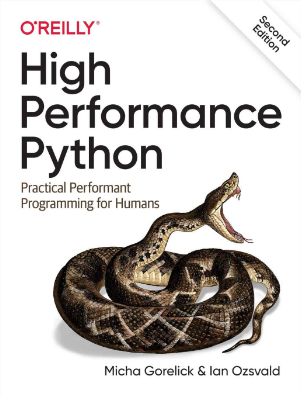
Oreilly High Performance Python by Micha Gorelick & Ian Ozsvald AI Consulting
Co-organiser
Trending Now
1Leadership discussion session at PyDataLondon 2024Data science, pydata, RebelAI2What I’ve been up to since 2022pydata, Python3Upcoming discussion calls for Team Structure and Buidling a Backlog for data science leadsData science, pydata, Python4My first commit to PandasPython5Skinny Pandas Riding on a Rocket at PyDataGlobal 2020Data science, pydata, PythonTags
Aim Api Artificial Intelligence Blog Brighton Conferences Cookbook Demo Ebook Email Emily Face Detection Few Days Google High Performance Iphone Kyran Laptop Linux London Lt Map Natural Language Processing Nbsp Nltk Numpy Optical Character Recognition Pycon Python Python Mailing Python Tutorial Robots Running Santiago Seb Skiff Slides Startups Tweet Tweets Twitter Ubuntu Ups Vimeo Wikipedia
